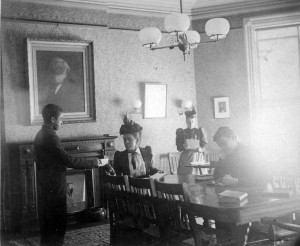Barnard’s History
The idea was bold for its time.
Upon its founding in 1889, Barnard became the only college in New York City, and one of the few in the nation, where women could receive the same rigorous and challenging education available to men. The College was named after educator, mathematician, and 10th president of Columbia College Frederick A.P. Barnard, who argued unsuccessfully for the admission of women to Columbia University. The school’s founding, however, was sparked by the rallying efforts of Annie Nathan Meyer, a student and writer who was equally dissatisfied with Columbia’s stance and staunchly committed to the education of women. She joined forces with a small group of her peers to petition the Columbia’s trustees for an affiliated liberal arts women’s college and in two years accomplished what she had set out to do.

The first Barnard class met in a rented brownstone at 343 Madison Avenue, just blocks from Grand Central Station; there was a faculty of six and 14 students in the School of Arts. Nine years later, the college moved to its present site in Morningside Heights. One of the original Seven Sisters, Barnard was, from the beginning, a place that took women seriously and challenged them intellectually.
In 1900, Barnard was included in the educational system of Columbia University with provisions unique among women’s colleges: It was governed by its own trustees, faculty, and dean, and was responsible for its own endowment and facilities, while sharing the instruction, the libraries, and the degree of the university. Somewhat ironically, when Columbia College finally went coed in 1983, as Frederick A.P. Barnard had wished nearly a century before, one might have thought Barnard would easily be subsumed. Instead, then-President Ellen Futter fought for the College to remain independent and worked toward a new and lasting agreement with Columbia in light of their decision to admit women.
Today, under President Laura A. Rosenbury, Barnard’s place in higher education is undeniably sound and strong. With the guidance of 13 women leaders over the course of 130 years — including winning the right to hire our own faculty in 1900, the pivotal protests of 1968, the historic admission of transgender women in 2016, and the opening of the Milstein Center in 2018 — Barnard has continued to flourish and excel.